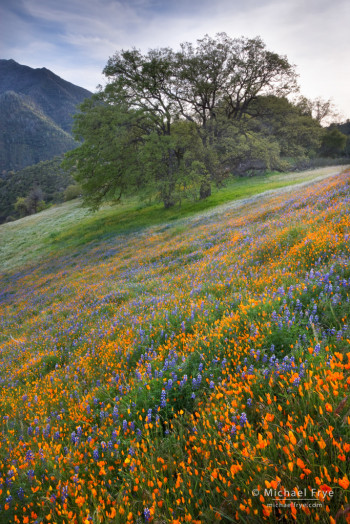
Poppies, lupine, and oaks blooming in an area burned by the 1990 A-Rock Fire, near El Portal, CA (photograph from April 2009)
Yesterday the Rim Fire reached an estimated 237,341 acres in size. That makes it the 4th-largest fire in California since they started keeping records in 1932. It has long since passed the record for the largest fire in the recorded history of the Sierra Nevada. Firefighters continued to make good progress, with containment at 80% as of last night. Even full containment doesn’t mean that the fire is out; it will continue to smolder until the first significant autumn rain or snowfall. But it will mean that firefighters don’t expect the fire to jump their containment lines and spread further.
Since the fire seems to be winding down, it might be a good time to look at some of the long-range consequences of the fire, and put it into perspective in relation to fire management, and the history of fire in this region. I’m not an expert on these matters, but several people who are experts present their views about the causes and consequences of the fire in this New York Times piece. The article includes a striking graph showing the effects of fire suppression during the last 150 years, and links to several other relevant articles. This piece from Wired describes the range of possible outcomes for the burned forest areas, and another article from SFGate covers the reasons why the fire suddenly exploded and burned 90,000 acres in two days.
As I said, I’m not an expert on fire management, but I have seen many fires during my years in and around Yosemite. I have vivid memories of the A-Rock and Steamboat fires of 1990, which closed most of the park for three weeks, and devastated the community of Foresta near the park’s western boundary. My wife Claudia and I lived in Yosemite Valley then, and she was nine months pregnant when the fires started. When she went into labor we had to get special permission to drive through the fire zone to the hospital in Sonora.
In 2008 the Telegraph Fire burned 34,000 acres outside the park near our home in Mariposa. Luckily the fire never got closer than three miles from our house, but 30 other homes were lost.
I’ve also lived in these mountains long enough to see the recovery and regrowth after fires. The next spring following the A-Rock and Steamboat fires I could see oaks and dogwoods crown-sprouting. Their roots were still alive, and shooting up new branches through the blackened soil. The spring following the Telegraph Fire brought the most spectacular poppy bloom anyone could remember to the burned areas in the Merced River Canyon, and even areas that didn’t burn got a fertilizer boost from the fire’s ash and produced a great display of flowers.
The photographs accompanying this post were all made in areas near Yosemite that were burned or fertilized by fires since 1990. After the huge, devastating Rim Fire, I hope these images will serve as a reminder that life will go on, and beauty will return to the areas that burned.
— Michael Frye
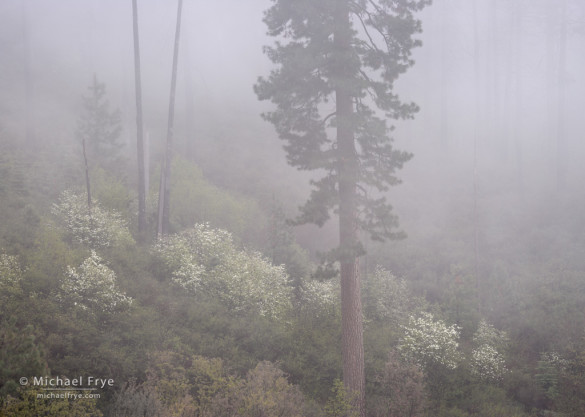
Dogwoods and ponderosa pine in fog in an area burned by the 1990 Steamboat Fire, Yosemite NP, CA (photograph from May 2013)
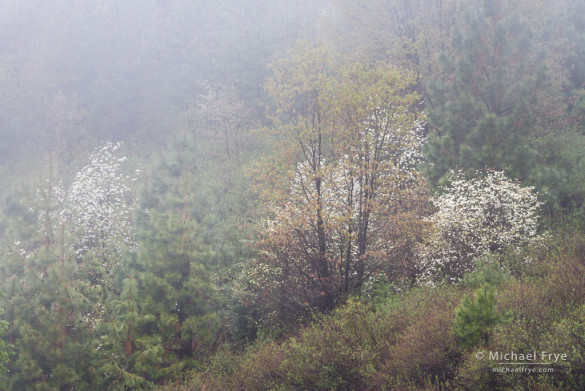
Dogwoods in fog in an area burned by the 1990 Steamboat Fire, Yosemite NP, CA (photograph from May 2013)
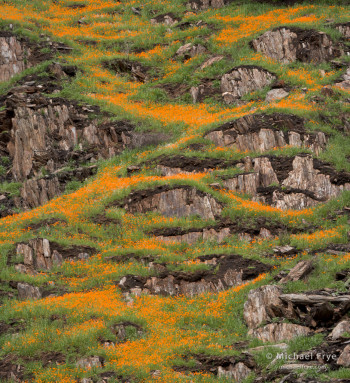
California poppies zigzagging across a hillside in the Merced River Canyon in an area burned by the 2008 Telegraph Fire, Stanislaus NF, CA (photograph from February 2009)
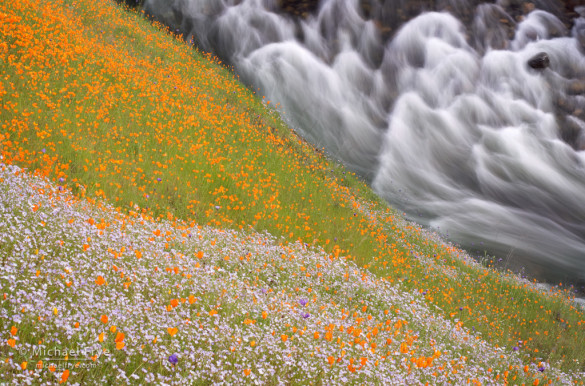
Wildflowers above the South Fork of the Merced River near Hite’s Cove. This area hasn’t burned recently, but ash from the 2008 Telegraph Fire fertilized the soil and fueled spectacular poppy blooms in 2009 and 2012. (Photograph from March 2009.)
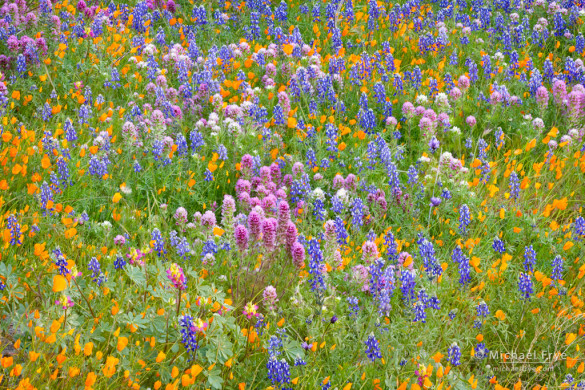
Wildflower mix—poppies, lupine, harlequin lupine, and owl’s clover in an area burned by the 1990 A-Rock Fire near El Portal, CA (photograph from April 2009)
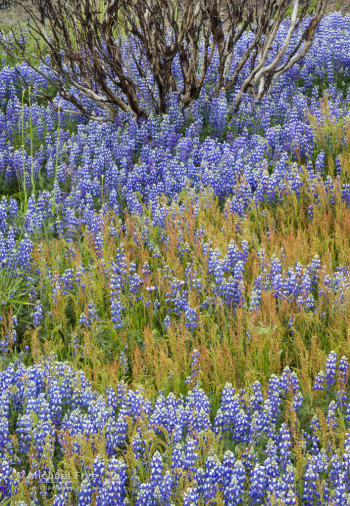
Lupines and burned manzanita after the 2009 Big Meadow Fire, Yosemite NP, CA (photograph from June 2010)
Michael Frye is a professional photographer specializing in landscapes and nature. He is the author or principal photographer of The Photographer’s Guide to Yosemite, Yosemite Meditations, Yosemite Meditations for Women, and Digital Landscape Photography: In the Footsteps of Ansel Adams and the Great Masters. He has also written three eBooks: Light & Land: Landscapes in the Digital Darkroom, Exposure for Outdoor Photography, and Landscapes in Lightroom 5: The Essential Step-by-Step Guide. Michael written numerous magazine articles on the art and technique of photography, and his images have been published in over thirty countries around the world. Michael has lived either in or near Yosemite National Park since 1983, currently residing just outside the park in Mariposa, California.
Did you like this article? Click here to subscribe to this blog and get every new post delivered right to your inbox!









Michael – Thanks for your wonderfully optimistic perspective (and as always, terrific photos of the area). I’ll say hi for my brother Dan here too!
Thanks Richard, and say hi back to Dan!
Michael, you have captured the fresh and newness of nature. The colors of a new beginning. The pics are outstanding. Thank you once again.
Thank you Patricia!
Michael, excellent articles you posted to read, very interesting! They certainly back up your thoughts and images. Nature surely does have a way of taking care of itself! I come away with a different perspective on the Rim Fire. Great images as always!
Thanks Marc, and I’m glad you had a chance to read those articles!
I too am inspired by your optimistic attitude. I enjoy reading your stories and love your photos. I tried to choose a favorite from this set, but couldn’t. All are beautiful.
the first one of El Portal, in 09 and the Wildflower Mix and Lupines and Burned Manzanita rank highest… not necessarily in any order. Love the dogwoods and oaks in fog too.
I am so happy to hear this fire is 80% contained. I’m praying for a good rain and snow season in Cali. While I am not living there right now, it is my home. I miss it.
Thanks for sharing.
–Deborah
Thanks very much Deborah, and I’m also hoping for a wet winter — along with everyone else in the state. 🙂
As always, your photography inspires. Fire is indeed a vital part of natures cycle, and in some instances, critical to the survival of some types of flora. As beings who are here on this orb for just a blip in time, we mourn the scars fire wreaks upon our beautiful forests, but, as you so beautifully captured in your images, fire can provide us with incredible beauty, as the forests rebound, grow and are renewed.
25 years in the Fire Service taught me to understand that encroachment of humans into wilderness areas have forced fire management policies in directions that ultimately have proven counterproductive. It’s a delicate balancing act and hopefully we will get better at it as time goes on.
Thanks very much Susan. I too hope that we will get better at that delicate balancing act in the future.
Thank you Michael for the beautiful pictures plus the information about fires renewing nature. Remember the terrible fire in Yellowstone? Everyone was sure the devastation would ruin it. Not so, it is better than ever where the fire was. No, I haven’t seen it myself. Hope to get there in the future.
Thanks Donna. It’s been too long since I’ve been to Yellowstone — I need to get back there. But it wouldn’t surprise me if those fires helped create better habitat for the wildlife.
Hite’s Cove–
Ghosts in Merced River
I love this one.
Thank you Sharon!
Sorry, missing two words
ghosts of ash in Merced River
Michael,
Wonderful images and text! Nature never fails to inspire me with her ability to recover from what we humans often consider tragedies. Whether natural (lightning) or human-caused (arson, terrorism, careless hunters or other) the only thing that continues to amaze me is the rapidity of the recovery. The Colorado Haymen Fire of 2002 is a good example with many aspen trees in the area now well over 6-8 feet tall. Even the land of last year’s Waldo Canyon Fire already shows good ground cover in many areas. Landscapes that contain large clumps of mature aspens remind me that those places are the younger parts of a forest that probably burned 50+ years ago and that pine trees will eventually replace them before the cycle repeats itself. It is through the lens of a camera that we can all document these changes over time and you are a major contributor to that saga.
Thanks James, both for the kind words about the photos, and for your perspective on the fires in Colorado. Let’s hope those areas grow back to be more beautiful than ever.
Michael, I’ve been a long time admirer of your images (great work), surprisingly our paths haven’t crossed much in the park. The Rim Fire has been really intense for us outside of Groveland as they were battling flames less than ½ mile from our property. My family was evacuated, some of the first official evacuations of the fire, I stayed on site with our neighbors to liaison with the fire crews and potentially put out spot fires if necessary. In between the anxiety and stress of the situation, I photographed the action in front of us. https://www.facebook.com/media/set/?set=a.538877229495130.1073741831.117817974934393&type=1 .
The timing and intensity of this fire and the steepness of many of the canyons that burned are going to have a serious impact on the natural recovery. We definitely need the rain, but a lot of precipitation will cause major erosion and loss of soil and native seed as well as other repercussions down the watershed. And unfortunately, we lost a lot of old growth forest that will take many generations to come back. It certainly is time to open the conversation about our wildlands management. You’re right, on the positive note, things will renew and it could be a great wildflower season in the spring.
Wow – fantastic photo Robb! You certainly had a front-row seat, though I bet you wish you hadn’t.
When wishing for rain I wasn’t thinking about the erosion. Hopefully we’ll get lots of rain, but nicely spaced and spread out so that the erosion is minimal.
The link should have gone to an album of Rim Fire images rather than one, but maybe I made a mistake.
I meant to say, “fantastic photos.” You had the right link, and sorry for the confusion.
I’m glad you’re there to capture those wonderful images. The SFGate Rim Fire article was most interesting and kinda left me feeling that we (Australia) have many similarities with fire management issues as California (after all, we were joined at the hip many moons ago) and reducing densities of the forests and forest floors. If people don’t wish to do the work, then they have to accept the most unpleasant consequences. Keep up your good work!
Thanks Janina. I’m sure there are many similarities between the U.S. and Australia regarding fire issues. Changing attitudes and policies is a slow process here.